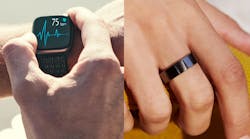Platform Slashes Six Months Off Development of Healthcare Wearables
Developers of wearable health monitors can recoup at least six months of development time using the Health Sensor Platform 3.0 (HSP 3.0) from Maxim Integrated Products, Inc. Also known as MAXREFDES104#, this ready-to-wear, wrist-form-factor reference design monitors blood oxygen saturation (SpO2), electrocardiogram (ECG), heart rate (HR), body temperature, and motion. Included algorithms provide HR, heart-rate variability (HRV), respiration rate (RR), SpO2, body temperature, sleep quality, and stress-level information at clinical-grade levels. It allows wearable designers to start collecting data immediately, saving at least six months over building these devices from scratch. Designed for wrist-based form factors, HSP 3.0 can be adapted for other dry-electrode form factors such as chest patches and smart rings.
Compared to its predecessor, Health Sensor Platform 2.0 (HSP 2.0), the HSP 3.0 adds optical SpO2 measurement and dry-electrode capability to the ECG. As a result, it can enable end solutions to monitor cardiac heart and respiratory issues for management of ailments like chronic obstructive pulmonary disease (COPD), infectious diseases (e.g. COVID-19), sleep apnea, and atrial fibrillation (AFib). Compared to its predecessor, the narrower form factor and enhanced optical architecture of HSP 3.0 improves signal-acquisition quality and uses upgraded microcontroller, power, security, and sensing ICs. The reference design includes complete optical and electrode designs, along with algorithms to meet clinical requirements.
HSP 3.0 or MAXREFDES104# includes the following sensor, power-management, microcontroller, and algorithm products:
• The MAX86176 is a low-noise optical photoplethysmography (PPG) and electrical ECG analog front end (AFE), which offers a 110-dB signal-to-noise ratio (SNR) to add SpO2 saturation capability and over 110 dB common mode rejection ratio (CMRR) for dry electrode ECG applications.
• The MAX20360 is a highly integrated power and battery management IC (PMIC) optimized for advanced body-worn health sensing devices.
• The MAX32666 is a Bluetooth (BLE)-enabled, ultra-low power microcontroller with two Arm Cortex-M4F cores and an additional SmartDMA which permits running the BLE stack independently, leaving the two main cores available for major tasks.
• The MAX32670 is an ultra-low-power microcontroller dedicated to Maxim’s PPG algorithms of pulse rate, SpO2, HRV, RR, sleep-quality monitoring, and stress monitoring.
• The MAX30208, a low-power, high-accuracy digital temperature sensor, comes in a small package size of 2 mm x 2 mm. It has 33% lower operating current compared to the closest competitive solution.
The HSP 3.0, also known as MAXREFDES104#, is available with hardware, firmware, and algorithms for $400 at Maxim Integrated’s website.
Maxim Integrated, www.maximintegrated.com

